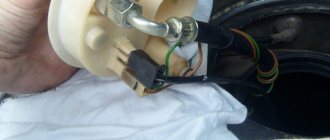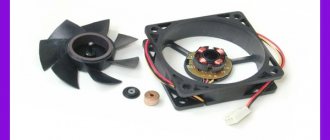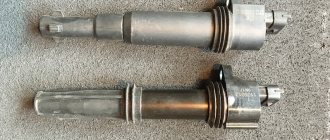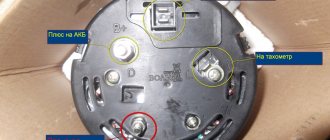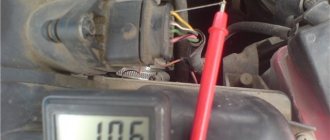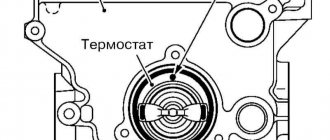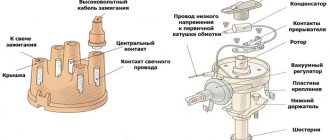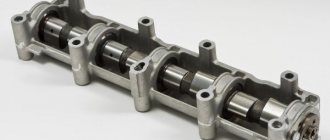Hello! Operating a car involves the need to constantly monitor and control its behavior, as well as the condition of the vehicle components. One of the key ones is the suspension. In this regard, I want to tell you how to check shock absorbers without outside help.
There is nothing complicated in carrying out diagnostic measures. And you can see this for yourself after reading the material. If the rear or front struts begin to wear out, or there are problems with the shock absorption system in the car, a check will let you know about this.
I advise you to do this while operating your car, as well as when buying a used car. By looking at the suspension you can understand the general condition of the car. If the car is new, there will definitely be no complaints about the suspension and shock absorber.
In total, we will consider 5 methods with you. 4 of them are performed independently. Another professional one, and involves testing on a bench.
Verification methods
While operating your car, you may have some doubts about whether the current shock absorbers are suitable or not. They come in front and rear on cars.
Regardless of where and what elements are on your car, the testing methods to identify problems are identical for all. I will only add that the shock absorber can be oil, gas or gas-oil. If you want to know which one is better, write in the comments. We will prepare a separate material on this topic, where we will discuss the strengths and weaknesses of each design option for a car shock absorber.
The main advantage of the methods is that the test can be carried out without removing them. These are express tests of performance and current condition.
Yes, removing the shock absorber will give you a better understanding of what's going on with it. After all, problems with the suspension do not always mean that the shock absorber is faulty.
All procedures presented are applicable to any vehicle:
- for VAZ 2107;
- VAZ 2110;
- on Gazelle;
- Lade Priora;
- Hyundai Accent;
- Daewoo Lanos;
- Renault Logan;
- Prado 120;
- Nissan Almera;
- Kia Sportage;
- Chevrolet Aveo, etc.
All ways to independently determine the malfunction of the shock absorber support or the shock absorber itself are divided into the following types:
- visual;
- rocking method;
- behavior;
- heat;
- bench test.
Now I propose to talk about each of them separately in order to clarify some of the nuances.
Visual method
For a visual inspection, you will need to carefully examine with your own eyes the condition of each of the shock absorbers installed on the machine. Here it is better to use a pit or overpass, and also take with you a portable source of good light.
There are several indirect signs indicating that the shock absorber is not working or its life is at its limit.
- If the machine has not been used for a long time, traces of corrosion appear on the surfaces of the shock absorbers;
- Most often, rust is noticed on visible areas of the stem;
- If there is rust, there is a high probability of oil seal wear;
- If there are traces of oil on the body, this is also a bad signal;
- This sign indicates depressurization;
- When an oil leak occurs, repairs sometimes help, but often the problem is eliminated by replacement;
- If you find traces of oil, wipe these areas with a dry cloth, and after a few days, look at these areas again;
- If oil reappears, they should be removed and replaced.
A leak of working fluid indicates that the integrity of the housing has been compromised. It's not worth using the car, but you can still use it for a while.
But the absence of corrosion and oil during a visual inspection does not guarantee that everything is fine with the shock absorber. There is still a possibility of wear and tear on the internal components of the structure.
Rocking up
Another method that allows you to diagnose a shock absorber malfunction. Often appears in various thematic videos. Quite easy to use and at the same time informative.
When to change a shock absorber
It is necessary to understand that regardless of the quality of the shock absorber, as well as the operating conditions of the machine, wear of this unit occurs constantly. With more or less speed, but constantly! Accordingly, their condition also needs to be checked constantly. Most shock absorber manufacturers in the mid-price category recommend checking every 20...30 thousand kilometers . As for replacement, usually the shock absorber wears out significantly after approximately 80...100 thousand kilometers . At this stage, you need to check it more thoroughly and, if necessary, replace it.
To ensure that shock absorbers last as long as possible, follow these recommendations:
- Do not overload the machine . The manual for any vehicle directly states its maximum load capacity. You should not overload the car, because this is harmful to its various components - including the engine and suspension components, in particular shock absorbers.
- Let it get into working mode . When driving a car in the cold season (especially during significant frosts), try to drive the first 500...1000 meters at low speed and avoiding bumps. This will allow the oil to warm up and spread.
Thus, if problems arise with the shock absorbers, it is better not to tighten it and replace the problem units with new ones. As for the purchase, it is better to buy licensed shock absorbers from the “officials”. Or choose products in trusted stores based on reviews from car enthusiasts.
We'll tell you and teach you
These subtle and almost invisible devices under the body not only make driving comfortable, but your safety and health directly depend on them.
Visual diagnostics
Take a close look at the appearance of the shock absorber. If traces of oil leakage are visible on the body of this device with the naked eye, this indicates a violation of the tightness of its chamber due to wear or damage to the sealing elements, for example, oil seals.
The damping properties of such a device will be either below normal or completely absent.
Even slight deformation of the shock absorber body can lead to difficulty in moving the piston or to its complete stop due to jamming.
The fastening elements of this damping device must not be broken or damaged by corrosion, and the rubber pads and bushings in the lower hinge must be intact, without visible signs of destruction.
The shock absorber rod should have a perfectly mirror-like surface. If this is not the case, then the piston stroke of this device is completely absent and the shock absorber does not perform its functions of damping vibrations of the suspension and body at all.
In many cases, tires serve as indicators of the technical condition of shock absorbers. Their excessive wear may indicate a malfunction of the shock-absorbing devices.
Checking the removed shock absorber
Place the dismantled shock absorber vertically and, fixing its lower bracket with your feet, pull it out several times with your hands, and then lower its rod down. For a working shock absorber, the resistance force to the upward movement of the rod should be many times greater than the resistance force to the downward movement of the rod.
To put it simply: the rod should go down relatively easily, and go up with considerable effort.
If the rod moves equally easily in all directions, it means there is very little fluid in the shock absorber cylinder or there is no fluid there at all.
A decrease in the resistance to movement of the rod in its positions close to the extreme ones will eloquently indicate the presence of air in the working cylinder of the shock absorber.
Checking shock absorber rebound
You can check the condition of the car's shock absorbers by rocking the front and then the rear. A car with faulty shock absorbers will perform more than one swing stroke, but if the strut of the shock absorber is jammed, it will not be possible to rock the car at all.
But this method of checking cannot always correctly assess the condition of damping devices. This applies to cars with new types of suspensions.
Assessing the condition of shock absorbers based on the vehicle's movement patterns
If when braking a car, when turning, on a wet and slippery road or under the influence of a strong side wind, the car constantly sways from side to side, and reacts reluctantly and late to steering movements, there is only one conclusion - it’s time to change the shock absorbers to new ones.
Do not neglect monitoring the technical condition of your car’s shock absorbers throughout its entire service life.
Be aware that a car with faulty shock absorbers becomes difficult to control; when braking, its braking distance increases significantly, and maneuvering can lead to swaying and roll, or even end with the car overturning.
Regardless of what type of suspension is installed, the car always uses shock absorbers. These are damping devices designed to dampen vibrations during suspension operation. The operating principle of the devices is to convert energy from mechanical to thermal. There are gas-filled and oil-filled shock absorbers. The elements work with suspension components such as springs, springs, cushions and torsion shafts. However, like any other part, suspension mechanisms fail. The shock absorber is no exception. How to check if it works? You will learn the answer to this question from our article today.
Symptoms of wear
As you drive the car, the struts and shock absorbers gradually wear out. This directly affects handling, directional stability, and braking efficiency.
The problem manifests itself when driving with the following symptoms:
- increased braking distance, sharp forward lean when braking;
- the appearance of rolls, wheel displacement during turns;
- swaying to the sides when moving;
- vibration of the steering wheel when driving on a flat road;
- creaks, knocks, and other strange sounds from the suspension;
- liquid leaks on the racks;
- uneven pronounced wear of tire treads with pieces of rubber falling off;
- body tilting back during sudden acceleration.
If at least one or more of these signs appear, then the time has come for a more accurate diagnosis of the condition of the struts and the shock absorbers themselves.
Why is it so important to monitor their condition?
The resource of this mechanism is about 60 thousand kilometers. This figure largely depends on the condition of the road surface. The shock absorber does not always maintain this specified period. It can fail at any moment. Therefore, you need to be guided not by the regulations, but specifically by the state of these damping devices. Why is it so important to monitor their condition? A faulty shock absorber can lead to wheel imbalance. As a result, the tire will wear unevenly. The car will skid at speed. Also, a faulty shock absorber reduces the life of the wheel bearings. They are quite expensive. But on many cars this unit is assembled with the hub. Therefore, the cost of repairs can be up to 20 thousand rubles.
Control driving
During normal city use, the gradual failure of the racks is not particularly noticeable. Control using simple exercises will help you identify the malfunction.
You need to go to a quiet place. There you should do:
- intense acceleration;
- sudden braking;
- snake
Faulty struts will significantly impair handling, which will be noticeable when performing exercises. It is prohibited to conduct tests on roads with heavy and moderate traffic, as an emergency situation may occur and the cost of testing will be too high.
Checking damping properties
This method consists of checking the performance of shock absorbers in a quiet state. So, the car is placed on a flat area. Next, one of its parts is vigorously swung by hand and checked after what period the body stops swaying.
The disadvantage of this method is that in this way you can only check a completely “dead” shock absorber. However, this is one of the fastest and cheapest (if not free) diagnostic methods. Another point is that the shock absorber does not always “walk”. Sometimes the rod simply jams. In this case, it will not be possible to rock the car.
UAZ trailer: description, technical characteristics, photos and videos
Heat
This is the least popular verification method among motorists. Although it has good accuracy rates.
It consists of checking the shock absorbers according to their degree of heating. The downside is that you have to work very quickly until the signs disappear due to natural reasons.
The point is this. You need to drive the car, then park on a pit or overpass, get to the shock absorbers and feel them with your hands. The thing is that during operation the shock absorbers heat up, generating a large amount of thermal energy. Feel all the elements. If one of them is cold or warm, although all the others are hot, the shock absorber has lost its functionality. It needs replacement or repair.
Bench diagnostics
If you want to get professional advice and a more accurate answer, you can contact a car service center where there is a special stand. The method is fast, not very expensive and informative if carried out correctly.
We determine the malfunction on the go
This is one of the most accurate ways to know whether the shock absorber is working properly. How can I check its condition? You need to carefully monitor the behavior of the car. If the car is constantly “looking for the way”, reluctantly reacts to the steering wheel and sways at the slightest irregularities, it means that the damping elements have become unusable. In large holes, characteristic dull impacts will be heard. But they do not always occur due to a broken piston. The silent block that holds the shock absorber in the upper or lower part may have worn out. During diagnostics, check the vehicle's behavior when cornering.
How to check it yourself
Very often, drivers resort to modern technologies, such as vibration stands, to check. But it often happens that you have to carry out diagnostics without such equipment, using only your own abilities and available materials. And for those who do not know how to check shock absorbers, I will tell you a rough plan of action.
The first step is to do a thorough inspection of these elements. This approach will allow you to identify obvious symptoms and possible malfunctions of the racks . For example, if during inspection you find that there are oil stains on the walls, then you should think about replacing the sealing elements, otherwise the shock absorber will become unsuitable for use, since running this mechanism “dry” will provoke rapid overheating and sudden wear of all elements receiving active participation in the work of racks. And most importantly, you will feel it yourself, with your butt.
The next thing you need to do is analyze the operation of the suspension, listen to see if there are any additional, unpleasant noises during its operation. If, when diagnosing the suspended part, you did not find any signs of failure, then you should safely assume that the knocking is occurring precisely because of faulty racks.
Diagnostics can also be carried out by rocking the car. What will this method do? If, when rocking, the car moves freely from side to side, then this is a clear sign of a malfunction of the struts. Given their excellent condition, it will be quite difficult for you to make the car sway. Since the main task of the racks is to dampen vibrations, if they work properly, the car will instantly level out and quickly return to a stationary position.
The last thing you can do to check the quality of the struts is to compare them with the work of another vehicle. You need to experiment with this at least once a month. Of course, this option may not bring a positive result, since the struts of another car may also be faulty, so you will not feel much of a difference. But sometimes this option can help you understand the difference between the performance of your shock absorbers and another vehicle.
Check with removal
Dismantling will help you find out exactly which of the four shock absorbers is faulty. The removed element is installed vertically relative to the ground. How to check rear shock absorbers? Its lower bracket is fixed with feet. Hands take hold of the upper rod and pull it out, then press down. A working shock absorber has good resistance force. If the rod moves with one hand and not under tension, it means the element is faulty. There is not enough working fluid in it, or there is air inside (does not touch gas-filled elements). How to check front shock absorbers and struts? Diagnosis is made in the same way. These elements are arranged in the same way, therefore, if the rod moves freely, such a mechanism must be replaced.
Visual inspection
Is it possible to determine if a device is faulty without removing it from the car? Yes, you can! And this is the cheapest, but, unfortunately, not very reliable way...
- It is necessary to visually inspect the rear and front shock absorbing elements . The devices are located behind the wheel springs. Although another option is possible, when the shock absorbers are supplied assembled with springs (MacPherson strut suspension). Evaluate its appearance. There should be no oily traces or other smudges on the surface of the flask. If they are, then your device has a breakdown.
- Inspect the rods (the inspection is carried out with the wheels in the hanging position) - it is better to do this by using a lift. If there is no access to it, then you should lift the car from the required side using a jack and pry off the boot. The rod should shine - rust on it indicates a faulty part.
- A breakdown of the shock-absorbing device can also be indicated by the tire itself . Assess the condition of the treads. All should show almost the same amount of wear.
Visual inspection of the shock absorber
Disadvantages of visual diagnostics
Unfortunately, a malfunction can only be determined by visual inspection in 50% of cases. Since incorrect operation of this element is usually caused by wear of its internal parts. But it is impossible to establish them during a routine inspection. Outwardly, you can only see the consequence of the malfunction - oily smudges, which, by the way, do not always appear, or eaten away protectors.
Vibration stand
It is not always possible to determine a breakdown without removing the element. However, there is a way that allows you to find out the problem at a professional level. How to check shock absorber struts without dismantling them? To do this, the car is driven onto a vibration stand. The cost of the service starts from 1 thousand rubles. At the same time, not only shock absorbers are checked, but also other suspension components, as well as the braking system. The vibration stand simulates road irregularities, allowing you to accurately determine the malfunction of a particular mechanism. The lateral rolling of the car is also checked (this way you can find out the serviceability of wheel bearings and ball bearings).
Shockabsorber-replacement-14_
There are known cases when, when diagnosing a car on a “shaky ride” with a working suspension and recently replaced shock absorbers, the data obtained indicated low residual effectiveness of the suspension. But during the “test drive” the car behaved perfectly. The reason is that the stand was not designed for more “hard” settings of the tuning series shock absorbers compared to the characteristics of the original products, as a result - a wrong verdict. Well, that happens.
A very important point! The final indicators may be influenced by such parameters as tire pressure, vehicle loading during diagnostics, small deviations from a straight line when driving to the stand (appearance of a deviation angle from the longitudinal axis), accidental installation of the vehicle on the handbrake, uneven loading of the vehicle during diagnostics, etc. .d. It will be a real pleasure for a careless repairman to “cheat” a client out of the cost of new shock absorbers, so that in the meantime, as if by accident, pump up his flat tire...
What are the benefits?
The advantage of checking this method is the high accuracy of fault determination in a short period of time. In addition, truck owners cannot do without such a service. After all, it is unlikely that you will be able to rock such a car with your hands (as in the second method). The vibration stand allows you to identify the problem in a complex manner. The only negative is the low prevalence of such stands throughout the city. And the price is not always acceptable.
So, we found out how to check the shock absorber for serviceability in various ways.

